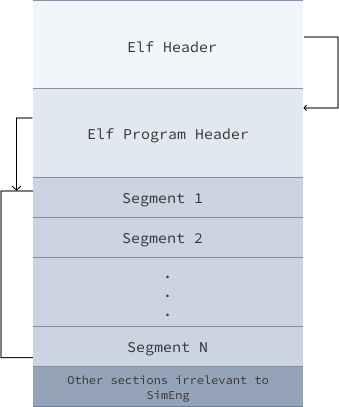Kernel¶
The Kernel used in SimEng is an emulation of a Linux Kernel. The SimEng Kernel does not seek to provide the full functionality of a Linux Kernel. Instead, it provides the functionality for creating the program memory space and aid the emulation of system calls by maintaining a system and process state.
The SimEng Kernel is split into two classes, LinuxProcess and Linux.
LinuxProcess¶
The LinuxProcess class provides the functionality to process the supplied program. It creates the initial process memory space, including the Executable and Linkable Format (ELF) process image and the stack. The process memory space created contains all the data required by the program to run.
ELF Parsing¶
The ELF binaries have a defined structure for 32-bit and 64-bit architectures, all information regarding parsing ELF binaries has been referenced from the Linux manual page. The ELF binary is divided into multiple parts. SimEng stores all relevant parts of the ELF Binary in a char[] processImage array, which is a private member variable of the LinuxProcess class.

The ELF Header is the first part of ELF binary. The ELF Header holds information regarding the structure of the ELF Binary. SimEng extracts the following from the ELF Header:
The entry point of binary i.e. the virtual address to which the system first transfers control.
The file offset of the ELF Program Headers.
The size of each entry stored in the ELF Program Header.
The ELF Program Header table is an array of structures, each describing a segment or other information the system needs to prepare the program for execution. An object file segment contains one or more sections, each section holds program and control information. SimEng extracts the following from the ELF Program Headers:
The offset from the beginning of the file at which the first byte of the segment resides.
The number of bytes in the memory image of the segment.
SimEng uses these extracted values to loop through all ELF Program Headers and looks for the ELF Program Header located at largest virtual address range. SimEng uses the largest virtual address and size associated with that ELF Program Header to create an array called the
ElfProcessImage. Internally, SimEng treats these virtual address as physical addresses to index into said array.The segment referenced by an ELF Program Header has a type attribute which explains its contents and how to interpret it. SimEng, only extracts segments of type
LOADwhich specifies a loadable segment. Loadable segments most notably contain the workloads’ compiled instructions and initialised data that contributes to the program’s memory space. This completes the creation of theElfProcessImage.After the
ElfProcessImagehas been created theLinuxProcessclass creates an arraychar[] processImage. The size ofprocessImageis much larger thanElfProcessImageas SimEng adds theHEAP_SIZEandSTACK_SIZEvalues specified in the YAML configuration file to the 32-byte aligned value ofElfProcessImagesize. After this, SimEng proceeds to create a process stack aroundprocessImage.The population of the initial stack state is based on the information here.
Currently, the only environment variable set is OMP_NUM_THREADS=1, however, functionality to add more is available.
For the supplied program, the LinuxProcess class supports both statically compiled binaries and raw instructions in a hexadecimal format.
Linux¶
The Linux class provides part of the functionality used to emulate system calls by maintaining a system and process state. These states contain information about the LinuxProcess class created from the supplied program. Such information includes:
PID
Program path
Start location for brk system calls
Current location of the most recent brk system call
The initial stack pointer
fileDescriptorTablethat tracks the open file descriptors
All system call functionality is invoked within the Linux class, and any return value associated with the system call is generated here.